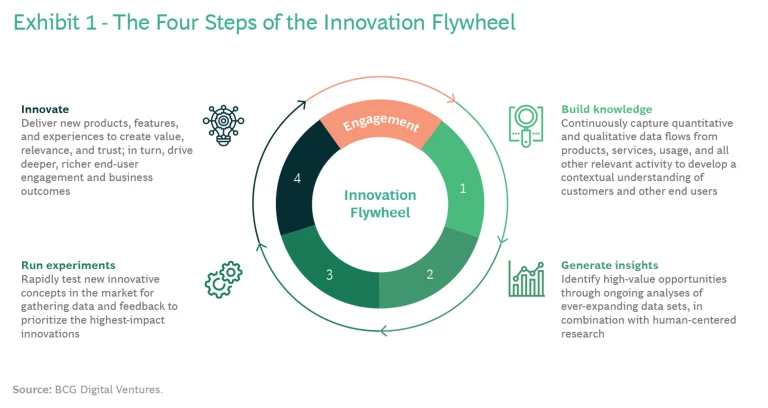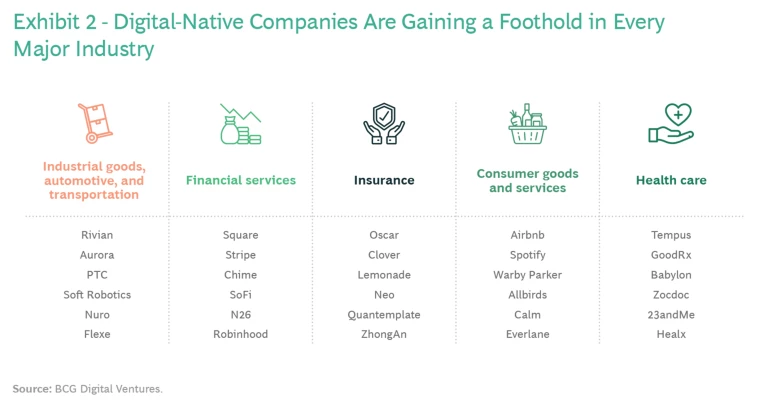This article is the first in our innovation flywheel series. Future articles will dive deeper into the mechanics of fully scaling the flywheel approach at the enterprise level, with specific focuses on technological and platform evolution, organization and team design, governance, funding, and change management.
The pandemic has put the power of digital on full display. Since February 2020, we’ve witnessed a full-on global embrace of the digital lifestyle. By some estimates, the percentage of grocery shopping conducted online tripled in 2020, the time spent streaming video entertainment jumped by more than 40%, and videoconferencing skyrocketed by over 110%. We’ve also seen perhaps the most sudden, sharp, and dramatic behavior shift in history with the near-universal adoption of remote and digital work. In just two months, more than 85% of private and public sector employers in the US officially switched to a work-from-home policy for nonessential workers—changing the lives of tens of millions of employees in the process.
The digital giants had a blockbuster year in 2020, with Netflix and Amazon setting the pace. These two companies saw explosive growth in their core businesses, with year-over-year revenues up 24% and 38%, respectively. Both saw a remarkable 70% gain in market capitalization. Newer digital attackers delivered even more eye-opening results. Peloton, the social-virtual fitness studio, added more than one million users in just 12 months, nearly tripled sales, and grew its stock price by 500%. The videoconferencing platform Zoom saw astronomical growth—from 10 million average daily users in December 2019 to more than 300 million just a year later.
For nondigital-native companies, 2020 was also eye opening. Business leaders across every industry are personally experiencing the ease and efficiency of the digital way of life. At the same time, out of necessity, they are pushing new levels of experimentation with digital—both externally with customers and internally with employees. And these experiments are working remarkably well. Customers are quickly and seamlessly shifting to digital channels, just as huge numbers of employees are adapting almost overnight to the new world of virtual work. What is more, these shifts are providing business leaders with firsthand evidence of the enormous scalability, flexibility, and compelling unit economics of the digital business model.
All these experiences are helping to bring digital’s potential into crystal clear focus. Many business leaders had already launched ambitious digital initiatives before 2020, but now they feel a renewed sense of urgency. They are doubling down with a sharper vision and a direct call to seize the opportunity. (See the sidebar.)
The Digital Native’s Definition of Digital
First, digital refers to the three foundational technologies that made their public debut with the launch of the World Wide Web in 1991: digitization, turning data and content into 0s and 1s; connectivity, transporting that data at light speed; and computing power, processing that data for a given purpose.
Second, digital refers to the next wave—to the derivative technologies born of the three foundational ones. These include AI, machine learning, computer vision, natural language processing, autonomous vehicles, robotics, augmented and virtual reality, conversational bots, the Internet of Things, 3D printing, and the blockchain.
Digital natives have grown up immersed in these technologies. For them, the exponential nature and inexorable march forward of these technologies were always a given. The third element of our definition, therefore, is that of a mindset. The digital mindset is rooted in a deep, intuitive appreciation of an interconnected world where data flows freely and instantaneously and computing power continues to accelerate exponentially. This means you need to learn fast, and the best way to do that is to build fast, iterate, and keep moving. You need to embrace openness, modularity, and flexibility. And because customers enjoy constantly growing access to data and applications, you need to put them at the center of everything you do and relentlessly drive toward relevance, engagement, and trust.
Digital technologies are not going to slow down. Rather, they will continue to accelerate and create an endlessly expanding universe of opportunities for reimagination and reinvention, affecting how we serve our customers, how we operate our businesses, and how we create value for our shareholders. Digital is no longer about websites, automation, and apps. It is about innovation—the systemic ability to continuously harness digital technologies to create competitive advantage in the core business.
The question at the top of CEO agenda: “How?”
- How do we build a new set of capabilities to harness digital innovation and create new competitive advantage in our core business?
- How do we push innovation out of the lab and into the hands of our frontline teams?
- How do we adopt new ways of working that enable us to move at digital speed?
- How do we attract and retain the next generation of digital-native talent?
- How do we drive and sustain innovation velocity across our entire organization?
LEARNING FROM THE DIGITAL NATIVES
Leaders can look first to Facebook, Apple, Amazon, Netflix, and Google (Alphabet) for some answers to these questions. Indeed, innovation velocity is the name of the game they have been playing for the last twenty years. This is not to suggest, of course, that the answer is as simple as trying to be like Amazon. Rather, there are important lessons and insights that can be drawn from these tech giants and applied to every business facing the inherent challenges of competing in the digital era.
At the heart of this approach is a concept called the innovation flywheel, the learning loop that powers everyday innovation.
The founders of these companies understood early on that digital would accelerate the speed of business competition. To match that speed, they embedded innovation in their culture, ways of working, organization design, and leadership model. In this way, they pushed innovation to frontline teams across their businesses and empowered those teams to relentlessly solve their customer frictions at the rockface—at the actual source and in real time. In effect, they made continuous, everyday innovation a primary source of their competitive advantage.
At the heart of this approach is a concept called the innovation flywheel, the learning loop that powers everyday innovation.
It is built around a foundational premise: the more you know about the customer, the greater opportunity you have to innovate and create value for that customer. Specifically, every interaction with an end user (customer or employee) generates information and data (qualitative and quantitative) that provide insights on where and how new value can be created. This in turn drives the next round of innovation, which leads to deeper engagement with the end user and to superior business outcomes. In effect, this process creates a self-reinforcing virtuous cycle of value generation. Once you get it spinning, it creates its own momentum and, like a flywheel, produces enormous—even transformative—energy. (See Exhibit 1.)
What digital natives understand, at a very intuitive level, is that digital technologies have massively accelerated this learning loop by enabling faster, more-frequent communication; faster, more-robust data capture; and faster, more-insightful analyses. In other words, in an increasingly digital world you can learn faster and, therefore, innovate faster across the entire value chain.
GROWTH ENGINE
The innovation flywheel is the engine that powered the remarkable 20-year run of Facebook, Apple, Amazon, Netflix, and Google to become some of the world’s most valuable companies. As of December 31, 2020, Netflix ranked in the top 25 most valuable companies by market capitalization. The other four ranked in the top ten.
In 2001, Google provided its customers with one application: a search engine. Today, the average customer engages with Google through a growing suite of products, services, and brands, including Gmail, Android, Play, Home, Nest, Docs, Sheets, Photos, and Calendar, to name a few. Through successive waves of new product launches and customer-interaction models, Google has woven itself into the fabric of the digital lifestyle, massively multiplying the intensity and frequency of its everyday customer engagement. It is estimated that more than 4 billion people use Google’s products or services regularly. On average, 63,000 searches are conducted on Google every second, and the company takes in 41% of all digital ad spending. It’s no coincidence that its search engine seems to anticipate your interests and offer up videos tailor-made for your viewing pleasure.
Amazon followed a similar flywheel strategy to power the growth of its core online shopping business, most notably through its Prime loyalty program, launched in 2005. During the last 15 years, Amazon Prime has grown to 126 million US customers, representing more than one in three Americans. Amazon has relentlessly driven higher customer engagement among its Prime base with a cycle of continuous innovation built around the shopping experience. For example, its one-click-to-purchase feature pioneered the seamless checkout. The company continually introduces popular new Prime services—such as online music, video, and gaming—and the average Prime customer reportedly spends about $1,400 annually on the site, more than double the average spending of non-Prime customers. Like Prime, Amazon Web Services proves that a rapid cycle of innovation, testing, and learning can lead to powerful new platforms capable of scaling. Such offerings are created by leaders who embed innovation velocity in their business model, matching the right talent to new growth areas.
Perhaps the most vivid example of innovation flywheel success is Netflix, whose entire business strategy is founded on a virtuous cycle of customer engagement. Netflix tracks over 50 billion hours of streaming content per year and uses a proprietary scheme to tag that content into more than 75,000 categories. The company leverages this data in combination with its clustering algorithms to customize video content for specific audiences, thereby driving deeper engagement with customers. In 2020, Netflix released approximately 500 original movies, specials, and series—a significant increase over the 371 it created in 2019, and well over the number released annually by the entire US television industry in the years prior to video streaming. Netflix has dramatically grown its user engagement, with average users spending more than two hours streaming its content daily in 2018 to more than three in 2020. This could be attributed in part to lockdowns, but even more more to the Netflix flywheel, which has powered a staggering 500% growth in its customer base over an eight-year period, from 32 million users in 2012 to over 200 million today. During that time, the company has released approximately 2,000 original movies, specials, and series, not counting the many others it has distributed.
THE FLYWHEEL INVASION
The most recent wave of digital attackers is pushing past the traditional high-tech industries, demonstrating the power of the innovation flywheel in new sectors and new contexts. (See Exhibit 2.)
Tesla, for example, is known for catalyzing a market shift toward electric vehicles. But its most disruptive move is not a powertrain—it is bringing a software mentality to the auto industry, treating each vehicle and driver as central points for flywheel innovation. The company captures as much as four gigabytes worth of data per day per vehicle through an array of sensors, cameras, and ultrasonics to gather information during every minute of driving time. Tesla continuously processes these data streams to improve vehicle performance and the quality of the driver experience, regularly sending over-the-air (OTA) improvements to each vehicle. As of 2020, the automaker’s Model 3 receives an OTA update every 16 days, on average.
Similarly, Slack is attacking the enterprise-communications market with its revolutionary digital messaging-and-file-sharing platform. The company has put enterprise employees at the center of its flywheel. Slack continuously captures massive amounts of individual user data and monitors direct customer feedback—estimates indicate more than 8,000 help tickets and over 10,000 tweets per month—to assess user frictions and identify new feature opportunities.
Square is driving innovation velocity in the payment and merchant services spaces, deploying continuous innovation to better meet the needs of small and midsize enterprises (SMEs). Square’s revolutionary point-of-sale device allowed even very small merchants to accept credit card payments and thereby brought hundreds of millions of cash transactions per year into the digital world. Square then used this massive data set to better predict fraud, enabling even the smallest businesses to immediately vet their customers during transactions. The company has continued to develop and launch new products and services—including business analytics platforms—by using its massive transaction-based data sets. In this way, Square can assess creditworthiness more quickly and accurately than traditional lenders, for example.
These digital-native attackers give some idea of what the innovation flywheel looks like at scale: ever-expanding customer engagement generating massive amounts of data and insights. This fuels constant innovation that can be used to drive deeper, richer engagement. Frontline teams are powering this cycle—inventing and delivering new products, solutions, and experiences—every day. Moreover, flywheel thinking has permeated the culture and is driving frequent innovation in every part of the organization. In all these ways, the basic human learning loop has become the DNA of the company. It is traceable from the individual performance level, to the digital-first operating model, all the way up to the business strategy.
These digital-native attackers give some idea of what the innovation flywheel looks like at scale: ever-expanding customer engagement generating massive amounts of data and insights.
A PLAYBOOK FOR NONDIGITAL INCUMBENTS
For market-leading incumbents, the innovation flywheel provides an opportunity to take a page from the digital natives’ playbook and use it to rapidly accelerate digital innovation. It starts with building and organizing a flywheel team around the end user. Top leadership presents the team with a clear challenge: find the friction, invent a solution, and launch it as fast as possible. Most critically, top leadership insists on a bias for action, explicitly deemphasizing the need for exhaustive planning and analysis. Immediate business impact is the paramount objective.
The biggest lesson from the digital natives, however, is that this creative leap of invention is only the first step. The real work happens after the product launch. The flywheel provides an operational blueprint for the team to drive successive rounds of continuous innovation, with the goal of hooking the end user in a virtuous cycle of engagement. Its playbook integrates the foundational methodologies of design thinking, lean, and agile into four steps that reduce risk and increase the chance of success:
- Build knowledge of the end user through feedback. Integrate quantitative and qualitative data so that the flywheel team can easily access it in real time. Leadership must set clear guardrails and protocols for personal data and privacy, as these are essential elements for guiding actions and decision making.
- Generate insights using an analytical toolkit and set of routines. Uncover new value by identifying where the biggest opportunities lie.
- Run experiments. Generate innovative solutions by structuring rigorous, rapid tests that monitor impact, drive KPIs, and eliminate waste and dead ends.
- Innovate. Build processes that allow for the continuous delivery of enhancements to products, services, and platforms.
By applying these disciplines, teams can innovate and execute faster. The flywheel approach is tuned to rapid, efficient experimentation. Increased velocity does not come from doing more work in the same amount of time, but rather, from only doing higher-impact work. Some companies are now taking this to the next level by using AI not only to run experiments (through the use of reinforcement learning, for example) but also to structure what is being tested in the first place.
UPS, the 110-year-old global leader in logistics, recently launched an innovation sprint to go after the $5.6 trillion B2B e-commerce market. The company started by focusing on its key customer base of SMEs and putting them at the center of the innovation cycle. This quickly surfaced major frictions. Many SMEs felt enormous pressure to meet escalating consumer expectations for one- and two-day delivery across the US without increasing their service costs. How could a typical SME achieve both goals, especially with limited cash flow?
With a bias for action, UPS’s flywheel team was able to design and launch a digital-first turnkey fulfillment business, Ware2Go, in less than ten months. Today, Ware2Go operates a nationwide, asset-light, and ultraflexible network of warehouses owned by third parties. The business pivoted to focus on SMEs operating in the B2C space in response to pandemic-driven disruptions in the B2B market. Ware2Go’s cloud-based technology platform provides SMEs with an integrated solution for storage, packing, and shipping services that allows them to scale up and down seamlessly as operational needs change.
The Ware2Go platform has a flywheel-based design that captures full end-to-end supply chain data streams for each customer. The product team also uses proprietary software that combines data models with machine learning to continuously enhance the intelligence and efficiency of the network. Ware2Go teams leverage insights from ongoing qualitative research and growing data sets to launch new business intelligence services, providing diagnostics and insights to their customers on how to gain efficiency across the fulfillment value chain.
Starbucks took an equally aggressive approach to build and scale its own innovation flywheel. In 2017, the company launched an innovation team to radically transform its digital engagement capabilities, with the goal of offering a fully personalized customer experience. This allows the company to deliver on its mission of focusing on “one person, one cup, and one neighborhood at a time.” Starbucks teams have operationalized the flywheel approach into a formidable advantage.
Capturing billions of data points each year allows Starbucks to generate insights about every aspect of the customer experience. A multidisciplinary team of designers, product managers, growth marketers, data scientists, engineers, and operators powers this operation. An underlying technology platform captures disparate data sources (including more than 90 million weekly transactions) along with product, loyalty, and store information, down to the individual customer level. The platform integrates this information with third-party data—related to location, shop profiles, weather, local events, and more—to power an evolving set of personalized offers delivered via mobile phones and in stores. Machine learning algorithms drive continuous optimization, enhance successive customer interactions, and respond with offers customized for each individual. Within just a few years of its launch, the Starbucks marketing flywheel has created phenomenal results. The number of offer variations in the market has increased by 100,000 times, the personalized marketing sales life has increased threefold, and it now takes the company one-tenth of the time to develop and launch offers.
INNOVATION AT SPEED AND SCALE
For companies that aren’t digitally native, the full potential of the innovation flywheel lies in scaling the approach and building out a new set of capabilities to drive innovation velocity in every part of the business. By launching successive waves of flywheel teams, leaders can create a snowball effect, whereby the teams reinforce each other’s efforts, enabling them to deliver even greater results to the business. Equally important, as more employees engage and enroll in this new way of working, they create critical mass. The digital-native approach to leadership, culture, talent, and technology takes root, enabling the the foundations of innovation at speed and scale.
By launching successive waves of flywheel teams, leaders can create a snowball effect, whereby the teams reinforce each other’s efforts, enabling them to deliver even greater results to the business.
At the most-successful digital companies, the prevailing approach to leadership is single-threaded: general managers are able to lead their multidisciplinary product teams with a singular focus on specific business outcomes. The culture is built around openness, transparency, creativity, and a bias for action, combined with a fanatical focus on data and metrics. It is designed to attract, motivate, and develop high-energy, high-performance individuals with entrepreneurial drive: the leaders of the future. Their ways of working are aligned with the digital-native playbook embodied in the flywheel, which provides a rigorous methodology and establishes clear roles and interrelationships between multidisciplinary team members, enabling them to make rapid progress together. Finally, the approach to technology is designed to optimize the flexibility, independence, and speed of each team. Exhibit 3 shows the four foundational enablers that underpin the flywheel approach and allow organizations to achieve innovation at speed and scale.
National Grid, a leading natural-gas and electric-power utility with operations in the US and UK, has scaled the flywheel approach to drive digital innovation and cultural transformation across its full business. In 2019, the company launched an effort to target key parts of its value chain, including field operations, network planning and maintenance, and customer-facing functions like sales, connections, billing, and service. It then launched innovation sprints to target a subset of these opportunity areas and tasked the sprint teams to design and launch a series of digital solutions and products to completely reinvent business processes and customer experiences.
The first wave of solutions have been launched. One of them is a field-force support platform designed to radically streamline and simplify network repair and maintenance operations. This solution is now being adopted at lightning speed across field operations, and early results show enormous gains in productivity and efficiency. Phase-one pilots have demonstrated the potential to reduce closure windows on field-repair jobs from an average of 77 days to 48 hours.
The flywheel design of this platform puts the line worker, supervisor, and clerk at the center of the innovation cycle. The platform design will enable each user to dynamically capture new sets of data on job status, location, equipment, asset condition, and more. The product team will use these data sets to identify the next, best opportunity to improve the user experience along with overall functionality and performance.
Another solution launched is a digital billing platform designed to fully reimagine how large commercial and industrial customers track, manage, and optimize their electricity usage and spending. Here again, the design puts the customers—in this case facility managers—at the center of the innovation cycle. An intuitive user interface enables customers to easily enter preferences and reconfigure reports and billing cycles according to their business needs. A product team captures this data, along with actual usage patterns, to drive the next round of innovative improvements in its platform experience to usher in broader and more frequent customer engagement with the platform.
National Grid now has more than eight of these flywheel teams underway, with a target of having more than 25 fully operational by the end of 2021. With increased internal momentum, business units are now rethinking their largest traditional IT technology programs and modularizing them to leverage the flywheel approach, with the goal of derisking these programs and accelerating speed to business impact. In addition, National Grid’s team is also using the momentum to push its teams beyond the short game, of solving immediate customer and business-process frictions, to the long game, which is focused on deploying frontier technologies across the full value chain, such as IoT sensors, machine learning, and artificial intelligence.
MAXIMIZING FLYWHEEL IMPACT
In our experience, there are five actions leaders can take to ensure their organizations successfully embrace the flywheel framework and maximize its full potential for value creation and organizational renewal.
Start small (but think big). Leaders should pick one problem and empower the team to solve it in a novel way. This is counter to traditional transformation approaches, in which new, bold programs are kicked off with fanfare and a heavy investment. Instead, leaders must set an immediate objective of reaching one very tangible milestone that has the obvious potential to unlock value. This could involve tackling a customer friction, an operational inefficiency, or a new market opportunity for expansion. Then, they can commission one flywheel team, empower its members to follow playbook principles, and challenge them to apply the art of the possible to invent a new solution. From there, it’s a matter of clearing the runway for the team to build that solution, launch it, and drive business impact as fast as possible.
Learn by building. Flywheel teams must build something useful and fast—and get it into the hands of users—to get feedback and make adjustments. The digital-native mentality makes it easy and efficient to learn directly from the end user. Leadership must therefore provide flywheel teams the license to start testing their concepts with customers immediately.
Adopt a “show, don’t tell” attitude. Flywheel teams must quickly produce tangible evidence to put in front of leadership. This contrasts with traditional large-scale programs, where complex backended business cases are created to justify large upfront commitments. Through a series of rapid-fire experiments, the teams need to generate data for technical and operational feasibility, end-user adoption, and business impact. In this way, they earn successive rounds of funding and executive sponsorship by convincing leadership with hard evidence.
Get the first flywheel spinning. The nature of a flywheel is that it takes substantial energy to make the first rotation happen. Leadership must therefore protect the early momentum achieved by the first wave of flywheel teams by proactively addressing the obstacles and organizational misalignment that these teams will inevitably encounter. An incumbent culture, sluggish decision making, and brittle legacy systems can act as brakes on the flywheel. Indeed, these are the structural barriers to innovation that every large organization encounters.
Fortunately, our experience is that after the early stages, the flywheel approach can generate the enormous energy required to overcome these seemingly intractable issues as more and more frontline employees enroll, new talent is drawn into the organization, and bottom-up cultural change takes root. In this way, the flywheel creates a second reinforcing loop around the attraction and retention of new talent. Digital natives view this as another primary source of competitive advantage.
Drive change from the inside out. Actions and results speak louder than vision statements and carefully crafted strategies. To inspire wide organizational change, leadership should put flywheel teams in the position to broadly showcase their new ways of working, as well as the business impact they are driving.
The enormous transformative potential of the flywheel approach extends across every critical element of the enterprise, from culture and talent to organization design, ways of working, and technology. The innovation flywheel creates it own momentum by starting small, focusing on driving rapid business impact, and energizing and empowering frontline teams. This approach can be championed by leadership teams regardless of sector, available budget, or the organization’s current position on the path to change.













